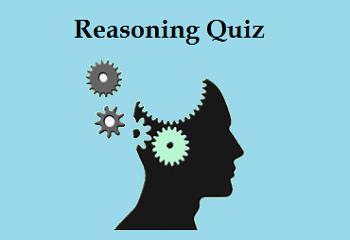Hello Aspirants. Welcome to Online Reasoning Section in AffairsCloud.com. Here we are creating question sample in coded Inequalities, which is common for all the competitive exams. We have included Some questions that are repeatedly asked in bank exams !!
Directions (1 – 10):
(A) only 1st follows
(B) only 2nd follows
(C) either 1st or 2nd
(D) neither 1st nor 2nd
(E) both 1st and 2nd
- Statements: K > B ≤ G = A, G ≤ P ≤ Q, A ≤ M
Conclusions:
I. Q > M
II. Q ≤ M(C) either 1st or 2nd
Explanation:
Q ≥ G = A ≤ M, this gives both Q and M less than equal to F
So either Q will be > M or Q will be ≤ M - Statements: Q ≥ P > K, P > F < C, A > W
Conclusions:
I. Q > F
II. A > C(A) only 1st follows
Explanation:
Q ≥ P > F, so Q > F
A > Q ≥ P > F < C, so relation cant be determined between A and C - Statements: Q > V < B ≤ P, A ≤ M ≤ V, G < M
Conclusions:
I. P > G
II. A < Q(E) both 1st and 2nd
Explanation:
P > V ≥ M > G, so P > G
A ≤ V < Q, so P < Q - Statements: L > P, P < N, N ≥ A
Conclusions:
I. A < P II. L > N(D) neither 1st nor 2nd
Explanation:
A ≤ N > P, so no relationship between A and P
L > P < N, both L and N less than P so no relationship between L and N - Statements: K ≥ T ≥ J, R < L, L > O
Conclusions:
I. O > T
II. K > L(D) neither 1st nor 2nd
Explanation:
O < L > R ≤ T, so relation cant be determined between O and T
K ≥ R < L, so relation cant be determined between K and L - Statements: S > M ≤ A, T ≤ M, Q ≤ B = T
Conclusions:
I. A > Q
II. A = Q(C) either 1st or 2nd
Explanation:
A ≥ M ≥ T ≥ Q
So A ≥ Q
So either or between two conclusions - Statements: P < E ≤ S, D > S < M, E ≥ A
Conclusions:
I. M ≥ A
II. D > A(B) only 2nd follows
Explanation:
M > S ≥ E ≥ A, so M > A
D > S ≥ E ≥ A so L > A - Statements: N ≥ P ≥ T, T < O, O > E
Conclusions:
I. E > P
II. N > O(D) neither 1st nor 2nd
Explanation:
E < O > T ≤ P, so relation cant be determined between E and P
N ≥ T < O, so relation cant be determined between N and O - Statements: L > A ≥ Z, P = A, S > L
Conclusions:
I. S > P
II. Z < S(E) both 1st and 2nd
Explanation:
S > L > A = P, so S > P
Z < L < S, so Z < S - Statements: P ≥ L > K, L > T < Q, B > P
Conclusions:
I. P > T
II. B > Q(A) only 1st follows
Explanation:
P ≥ L > T, so P > T
B > P ≥ L > T < Q, so relation cannot be determined between Q and B
AffairsCloud Recommends Oliveboard Mock Test
AffairsCloud Ebook - Support Us to Grow
Govt Jobs by Category
Bank Jobs Notification



